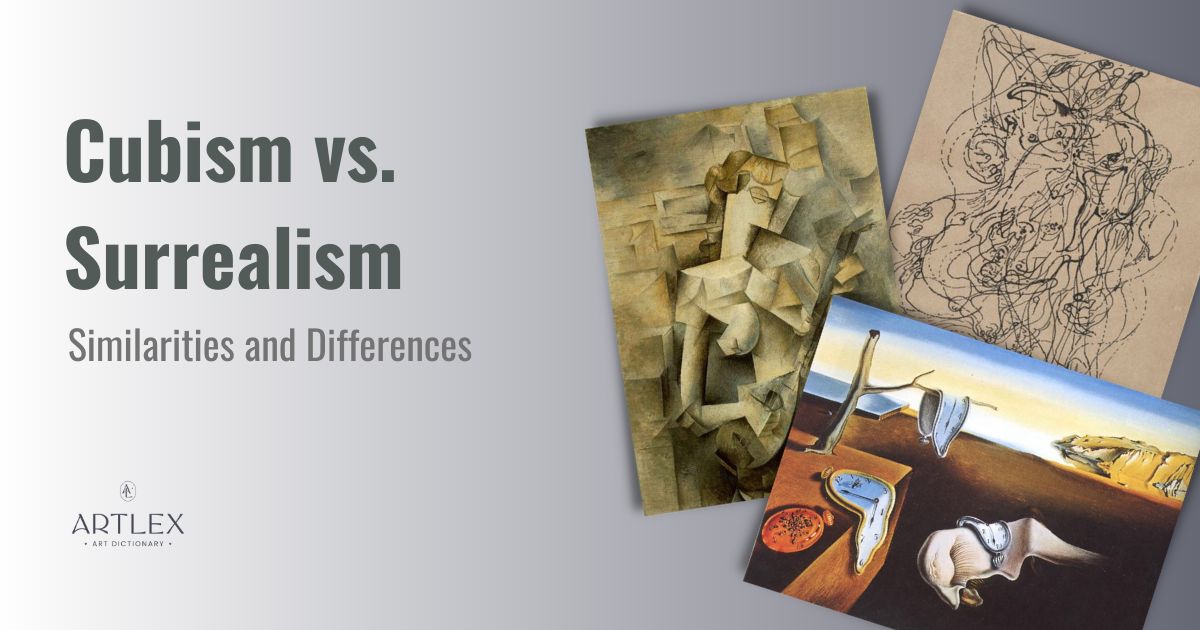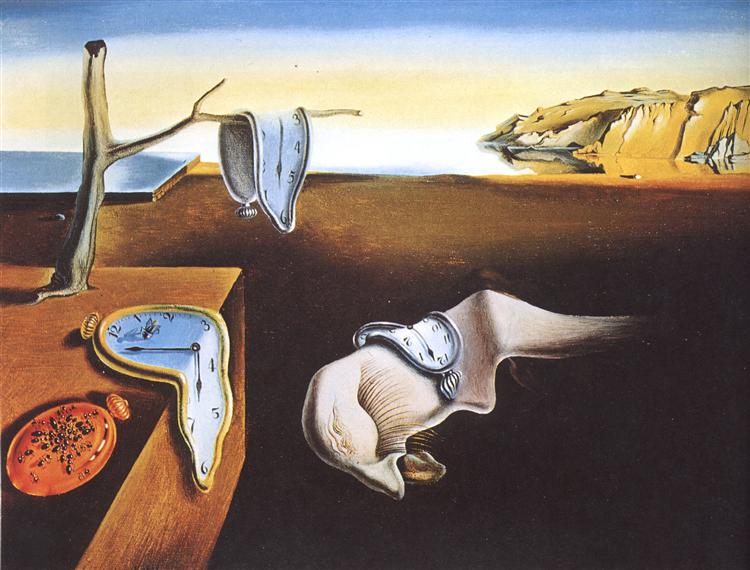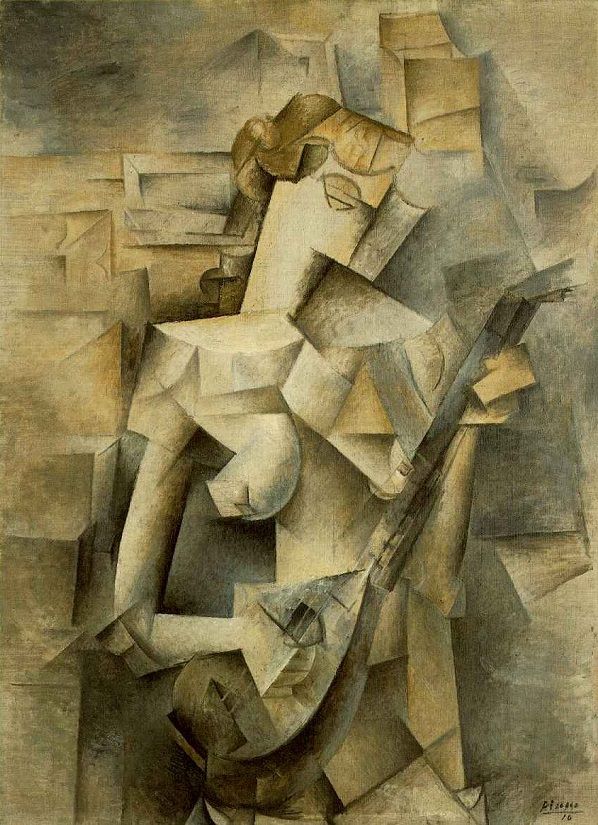
Cubism and Surrealism share many characteristics even though, as Modern art movements, they differ greatly.
Cubism emerged around 1907 and lasted until 1914. Cubism is defined by its unique appearance due to artists rejecting the artistic traditions of perspective, modeling, and foreshortening. Cubist artwork typically features a fragmented composition representing the subject from all angles or with overlapping, geometric planes. Artists Pablo Picasso and Georges Braque led Cubism through its phases: Proto-Cubism, Analytical Cubism, and Synthetic Cubism.
Surrealism emerged in the 1910s, was made official in 1924, and lasted through the second World War. Surrealism has no precise end date. However, some art historians consider the death of founder André Breton (1966) or that of artist Salvador Dalí (1989) as possible endpoints for Surrealism as a unified movement. Surrealist artwork draws on the psychoanalytic theories of Sigmund Freud and explores the subconscious human mind. Surrealist painting was inspired by dreams, nightmares, and automatic processes resulting in uncanny combinations of objects, people, and landscapes. These uncanny combinations are why much Surrealist art appears nonsensical.
For more information see our full Surrealism Guide.
Cubism and Surrealism have many similarities, although they may not seem like it at first glance. Three similarities between Cubism and Surrealism include both movements having two major stylistic phases, envisioning new or alternate realities, and a tendency toward abstraction.
Three differences between Cubism and Surrealism are influences, illusionism, and the fact that Surrealism was a cultural movement.
Cubism and Surrealism Similarities
Cubism and Surrealism are filled with familiar objects that appear strange or mysterious because they challenge our perception of the world around us. Both movements underwent two significant phases that marked an evolution in style and technique, envisioned reality in a new or alternate way, and had elements of abstraction, whether intended or involuntary.
Cubism vs. Surrealism: Two Major Stylistic Phases
Cubism is divided into two major stylistic phases: Analytic Cubism and Synthetic Cubism. Analytic Cubism focused on analyzing the subject matter piece by piece and reassembling it as a multifaceted image. Synthetic Cubism focused more on constructing the reality of space on a flat surface, usually a canvas.
Surrealism also consisted of two main styles: Automatic Surrealism and Veristic Surrealism. Automatic Surrealism favored automatic processes such as automatic drawing, frottage, and decalcomania. This style of Surrealism produced artwork that was typically very abstract. Conversely, Veristic Surrealism uses illusionistic dream imagery to construct uncanny scenes using illusory subject matter, such as dreamscapes.
André Masson’s Automatic Drawing, below, demonstrates a finished automatic drawing:

Cubism vs. Surrealism: Envisioning New or Alternate Realities
Both Cubism and Surrealism rejected depicting reality as it appeared. Instead, both art movements reimagined aspects of reality using avant-garde methods. Surrealism explored the deepest layers of the human mind and presented them as reality. Cubism studied its subjects from all angles, making objects and people entirely visible within a single picture plane.
Salvador Dalí’s The Persistence of Memory (1931) demonstrates Surrealism’s preoccupation with dreamscapes and the subconscious, where Dalí conveys the dreamscape below as though it were a veritable landscape:

Cubism vs. Surrealism: Leaning Towards Abstraction
While early Cubist work is still highly representational, later Cubist work begins to lean towards abstraction. Cubist style was a crucial factor in the development of abstract art, even though Picasso or Braque did not explicitly seek abstraction. Some Cubist artists, like Robert Delaunay, moved on from Cubism to intentionally create abstract art.
Cubism and Surrealism Differences
While Cubism and Surrealism may share many similarities, their influences are very different. Surrealism embraces illusionism, where Cubism rejects it. Cubism was also a prominent visual arts movement, whereas Surrealism, best known as an art movement, was part of a broader cultural movement in response to the second World War.
Cubism vs. Surrealism: Influences
Cubism was influenced by African and Cycladic art, whereas Surrealism was influenced by automatism, dreams, nightmares, and subconscious thought. Psychoanalyst Sigmund Freud’s theories on the unconscious mind and psychic automatism were particularly influential to Surrealists such as Salvador Dalí and Max Ernst.
Cubism vs. Surrealism: Illusionism
Cubist artists rejected illusionism, whereas Surrealist artists often embraced it for its ability to create the illusion of a real object or scene. Surrealists such as Salvador Dalí, Rene Magritte, and Yves Tanguy often depicted their hallucinatory scenes in such meticulous detail that they seemed real.
On the other hand, Cubists sacrificed the imitation of reality by attempting to explore pure form in a new, semi-abstracted reality where all facets of a subject could be seen at once.

Cubism vs. Surrealism: Surrealism as a Cultural Movement
In addition to being an artistic movement, Surrealism was also a literary movement. Much like Surrealist paintings, Surrealist literature sought to trouble an already troubling reality in the wake and aftermath of World War II. Surrealist film, theater, and music were also popular during this time.
Cubism was purely related to painting, sculpture, and papier collé. Cubist artists’ main concern was to show objects, people, and landscapes in their purest visual form. The depiction of subjects from multiple viewpoints allowed artists to represent the subject in a broader context.
What are Other Art Movements Similar to Cubism and Surrealism?
Although Cubism and Surrealism did not have a clear or direct influence on each other, these avant-garde art movements were closely related to coexisting movements such as Dadaism and Post-Impressionism. Many Dada, Cubist, and Post-Impressionist artists dabbled in Cubism before finding their roots in Surrealism, such as Frida Kahlo and Salvador Dalí. Even as a famed Cubist, much of Pablo Picasso’s work throughout the 1920s incorporates characteristics of Surrealism.
Surrealism is generally said to have emerged from Dada, with André Masson’s automatic drawings signaling a break from Dada. Dada emerged in reaction to World War I and sought to reject logic, reason, and modern capitalist society. Dada artwork expressed nonsense and irrationality in protest of bourgeois culture. Surrealism demonstrates a similar discontent towards war, radical politics, and the present turmoil.
Cubism and Surrealism influenced the Postmodern art of the late 20th century. Pablo Picasso’s drawing style influenced aspects of Pop Art, and Surrealism as a whole influenced Postmodern art movements such as Conceptual art and installation art.
